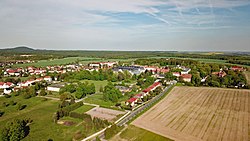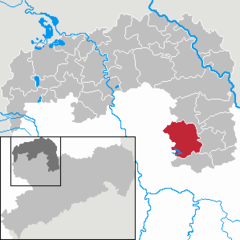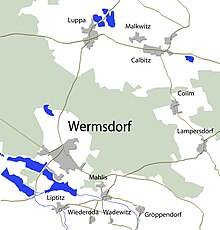
Moritzburg is a municipality in the district of Meissen in Saxony, Germany, between Meissen itself, an early centre of Saxony, and today's capital Dresden. It is most famous for its Baroque castle, Schloss Moritzburg.

Strehla is a small town in the district of Meißen, Saxony, Germany. It is located on the river Elbe, north of Riesa. This place name means arrow in Sorbian. Strehla includes the following subdivisions:

Kreischa is a municipality in the Sächsische Schweiz-Osterzgebirge district, Saxony, Germany. It directly borders the Saxon capital Dresden and consists of 14 districts.

Oschatz is a town in the district Nordsachsen, in Saxony, Germany. It is located 60 km east of Leipzig and 60 km west of Dresden.

Augustusburg is a town in the district of Mittelsachsen, in Saxony, Germany. It is situated 12 km east of Chemnitz. Augustusburg is known for its Jagdschloss, the hunting lodge of the same name.
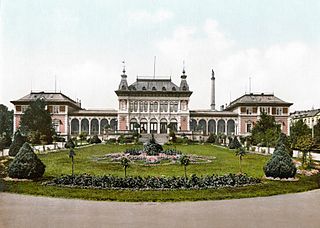
Bad Elster is a spa town in the Vogtlandkreis district, in Saxony, Germany. It lies on the border of Bavaria and the Czech Republic in the Elster gebirge hills. It is situated on the river White Elster, and is protected from extremes of temperature by the surrounding wooded hills. It is 25 km southeast of Plauen, and 25 km northwest of Cheb. It is part of the Freunde im Herzen Europas microregion.

Bernstadt auf dem Eigen is a town in the Görlitz district, in Saxony, Germany. It is situated 16 km north of Zittau, and 16 km southwest of Görlitz.

Dahlen is a town in the district Nordsachsen, in Saxony, Germany. Since 1994, the town of Dahlen consists of the old town with the addition of neighbouring villages Börln with Bortewitz, Radegast and Schwarzer Kater, Großböhla, Neuböhla and Kleinböhla, Schmannewitz and Ochsensaal.

Ehrenfriedersdorf is a town in the district of Erzgebirgskreis, in Saxony, Germany. It is situated 8 km northwest of Annaberg-Buchholz, and 21 km south of Chemnitz.

Kitzscher is a town in the Leipzig district, in Saxony, Germany.

Lauta (German) or Łuty is a town in the district of Bautzen, in Saxony, Germany. It is situated 10 km west of Hoyerswerda, and 10 km southeast of Senftenberg.

Mügeln is a town in the district Nordsachsen, in Saxony, Germany. It is located 9 km southwest of Oschatz and 14 km northwest of Döbeln. The town has a population of approximately 5,808 people.
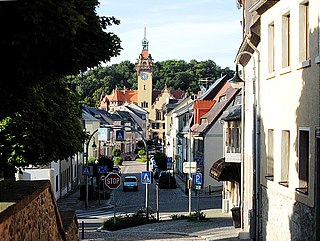
Waldheim is a town in Mittelsachsen district, in Saxony, Germany.

Neukirch/Lausitz (German) or Wjazońca is a municipality in Upper Lusatia in the district of Bautzen, in the state of Saxony in eastern Germany. It belongs to the district of Bautzen and is situated in several valleys of the mountain region Lausitzer Bergland, near the hill "Valtenberg" that reaches about 587 metres. It has about 5,066 inhabitants in an area of 21.32 km², a population density of 240 per km². The German name Lausitz means Lusatia.
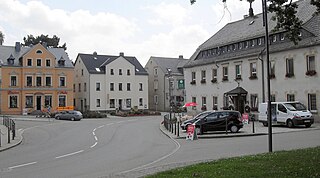
Eppendorf is a municipality in the district of Mittelsachsen, in Saxony, Germany.

Crostwitz (German) or Chrósćicy is a village and municipality in the center of the German district of Bautzen in Saxony. It is located in Upper Lusatia and is one of the centres of the Sorbian settlement area in Saxony.
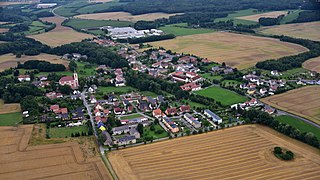
Nebelschütz (German) or Njebjelčicy is a Sorbian village in the district of Bautzen of Saxony in south-east Germany. It lies to the south-east of Kamenz.

Arzberg is a municipality in the district Nordsachsen, in Saxony, Germany.

Liebschützberg is a municipality in the district Nordsachsen, in Saxony, Germany.

Collmberg, regionally and colloquially called Collm, is the highest elevation in the Nordsachsen district and of the Northwest Saxon Basin, situated 6 km west of Oschatz near the small village of Collm. Until the 19th Century it was also called Spielberg and has also been known as Oschatzer Collm.
